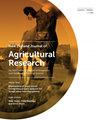新西兰农业部门除草剂抗性测试服务的价值
IF 1.5
3区 农林科学
Q2 AGRICULTURE, MULTIDISCIPLINARY
New Zealand Journal of Agricultural Research
Pub Date : 2023-05-07
DOI:10.1080/00288233.2023.2209328
引用次数: 1
摘要
本文章由计算机程序翻译,如有差异,请以英文原文为准。
The value of a herbicide resistance testing service for the agricultural sector in New Zealand
ABSTRACT A government research grant and industry co-funding allowed us to briefly provide free tests of suspected cases of herbicide resistance using traditional seedling-based assays. Information about the service was disseminated through the Foundation for Arable Research and other weed management professionals. Between 2019 and 2022 we received 248 seed samples collected by rural professionals from individual plants suspected of resistance. We successfully tested 195 samples from eight species from 57 farms. Rural professionals were good at recognising cases of resistance; 77% of these seed samples from 40 farms (70%) had resistance confirmed. We gained insights into contextually unique cases of resistance previously undescribed in the literature in New Zealand, including ryegrass resistance to glyphosate in a barley crop, Poa annua resistance to iodosulfuron in wheat, and Phalaris minor resistance to iodosulfuron in wheat. Resistance was typically confirmed 6–8 weeks after planting seed samples, though for species with seed after-ripening requirements to ensure consistent germination, results took as long as 6 months. The results facilitated conversations about long-term resistance avoidance strategies. Future costs of an independent resistance testing service would ideally be shared by the stakeholders benefitting from the crop protection product value chain, from herbicide producers to land managers.
求助全文
通过发布文献求助,成功后即可免费获取论文全文。
去求助
来源期刊
CiteScore
4.90
自引率
16.70%
发文量
31
审稿时长
3 months
期刊介绍:
The New Zealand Journal of Agricultural Research publishes original research papers, review papers, short communications, book reviews, letters, and forum articles. We welcome submissions on all aspects of animal and pastoral science relevant to temperate and subtropical regions. The journal''s subject matter includes soil science, fertilisers, insect pests, plant pathology, weeds, forage crops, management systems, agricultural economics, agronomy, and animal science. The journal also accepts crossover papers on subjects such as land –water interactions.

 求助内容:
求助内容: 应助结果提醒方式:
应助结果提醒方式:


